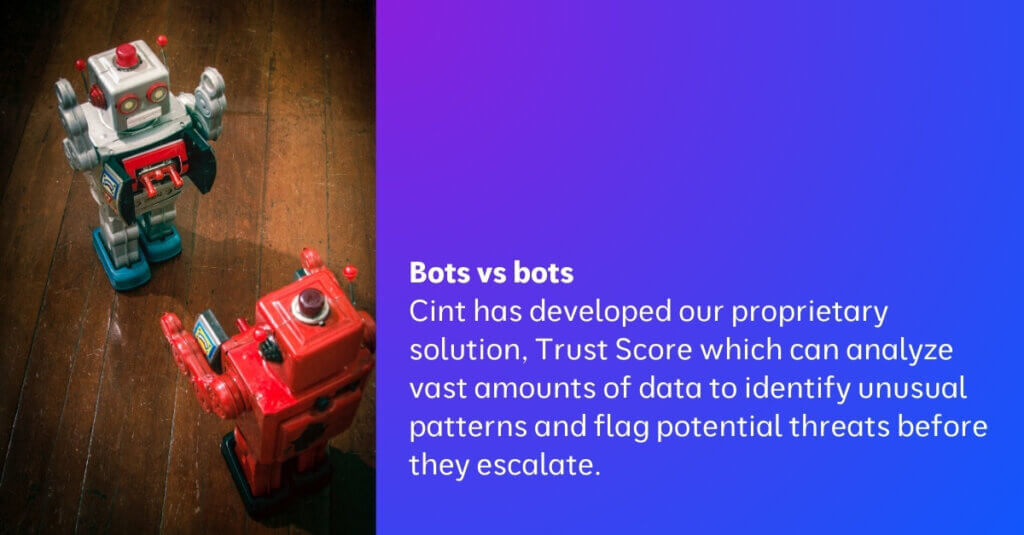Cint’s Jimmy Snyder, Vice President of Trust and Safety, and Shelby Downes, Senior Program Manager, discuss a range of approaches for taking action against the bots.
The rise of AI
As artificial intelligence (AI) continues to evolve it offers a treasure trove of benefits, such as improving the diagnostic capabilities of medical practitioners and summarising product reviews for consumers.
However, AI can also be misused. The world is already seeing AI used to help students cheat on exams and deepfakes used to spread misinformation. Concerns are also growing about the usage of AI by criminals with experts hypothesizing and gathering data on the impact.
The Market Research industry is not immune to this rise of AI-driven fraud. From bots completing open-ended questions to sophisticated click farm schemes, the implications of AI-enabled fraud are profound and far-reaching. That’s why it’s imperative to understand how to proactively combat these threats with equally advanced technology.
Understanding AI-driven fraud
AI-driven fraud leverages machine learning algorithms to mimic human behavior, making it increasingly difficult to detect and prevent. This poses challenges for the market research industry which is built on attempting to understand and predict human behaviors.
Generative chat tools such as Chat GPT provide simple access to technology capable of producing believable survey responses. This capability risks generating unrepresentative and inaccurate answers, undermining trust in the industry’s quality and causing notable financial implications along the research chain.
Why is combating AI-driven fraud essential?
Safeguarding information integrity
AI-driven fraud threatens the integrity of the data collected by researchers. This data is used to make real-life decisions by individuals, businesses, and even political parties. Misinformation due to poor-quality data can lead to misguided opinions, bad business decisions, and influence elections. By employing advanced technology to combat these threats, we can help preserve the information integrity and rebuild trust in the industry.

Maintaining trust
Businesses are increasingly vulnerable to AI-enhanced fraud. By investing in technology to combat fraud, companies can protect their reputations and maintain customer trust. Failure to do so could lead to significant financial losses and even legal ramifications.
Protecting businesses and financial security
The primary motive behind most fraud is financial gain which comes at the cost of financial losses for their targets. As fraudsters use AI to enhance their tactics, individuals and organizations face heightened risks. Protection of singular entities is crucial for our entire industry given how much businesses intersect. An effective response to AI-driven fraud can help maintain financial stability within companies and the industry.
Strategies to combat AI-driven fraud
It isn’t all doom and gloom when it comes to AI. There are many strategies that businesses can deploy to fight this new automated foe. These include:

Bots vs bots
Leveraging machine learning and AI to detect fraudulent activities can significantly enhance prevention efforts. Cint has developed our proprietary solution, Trust Score which can analyze vast amounts of data to identify unusual patterns and flag potential threats before they escalate.
Never stop innovating
Fighting AI fraud necessitates the development of new technologies, fostering innovation in cybersecurity and AI ethics. By prioritizing research and investment in these areas, we can create a more secure digital landscape and drive overall technological advancement. Cint has a robust roadmap for our quality solutions. Our Platform Intelligence team validates the effectiveness of solutions and ensures decisions are made based on data.
Deploy your humans
Deploying technology to combat AI fraud is essential; however, businesses should also focus on implementing operational measures and processes to identify what technology may overlook. By addressing these gaps, organizations can enhance their protections and identify areas of improvement for technology. Cint runs programs to improve quality across all our pillars of quality; buyer, supplier, product, respondent, service/operational.
Make every day a learning day
Training employees and the public about the risks associated with AI-driven fraud is vital. Cint runs awareness programs to equip individuals with the knowledge to recognize and report suspicious activities, creating a more informed society. We also speak directly to our customers and publish informational blogs such as this one to spread awareness!

We’re in this together
Collaboration and cooperation across the industry is essential in combating AI fraud. Tech companies, financial institutions, and regulatory bodies coming together can lead to the development of more effective solutions and standards. Cint is participating in the Global Data Quality Initiative that brings these parties together.
Maintain your moral compass
Developing and adhering to ethical guidelines for AI use can mitigate the risks associated with its misuse. By promoting transparency and accountability in AI development, we can help ensure that these technologies serve the greater good. All Cint employees sign an AI usage policy as part of remaining accountable when using AI responsibility.
Conclusion
With the rapid growth of AI technologies, regulatory frameworks are struggling to keep pace. Organizations that proactively address AI-driven fraud not only protect themselves but also contribute to a more robust regulatory environment. By adopting advanced fraud detection systems, businesses can help shape policies that foster ethical AI use and accountability.
Fraud is becoming increasingly sophisticated. It’s crucial to recognize the importance of fighting AI-driven fraud with innovative technological solutions. By prioritizing security, integrity, and collaboration, we can protect the entire industry. The battle against AI fraud is not just a technological challenge; it’s a societal imperative that requires our immediate attention and action.


































































































